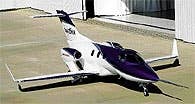
While much of the aviation world these past few years has been focusing on a couple of high profile start-up companies looking to certify and produce light business jets, one of the richest companies in the world has been busy behind the scenes doing the exact same thing. It has not been a particularly well-kept secret, but late last year Honda finally made the news public: it's developing a light jet and the turbofan engines to power it.
While Honda-built jets have been under development since 1986 (flying with engines from other manufacturers) and the company has been developing a turbofan since 1999, the flight in December was the first time the company's airplane and engines have gotten together to go flying.
The light six-place jet, called for now the "HondaJet," is slightly smaller than a Cessna CJ1 and, based on Honda's projections, faster, too-420 knots at cruise. Maximum range is around 1,100 nm. The Honda features a unified composite structure and single-piece aluminum wing skins. The engines are mounted on pylons on the wing, which eliminates structure in the fuselage and allows more interior cabin space, up to 30 percent more, claims Honda.
The HF118 engine is a medium-bypass turbofan putting out 1,670 pounds of thrust at takeoff. Honda developed the engine's compact FADEC system, which it says is the first of its kind for a small turbofan. The engine has logged more than 100 hours of flight testing on other manufacturers' aircraft. Honda claims the engine, mated with its airframe, will improve fuel efficiency by better than 40 percent.
Perhaps the most interesting thing about the HondaJet is that the company has been working on the project for more than 15 years and has yet to announce whether it will ever certify or produce an airplane as a result. It does say, however, that it plans to continue the flight test program.

Sign-up for newsletters & special offers!
Get the latest FLYING stories & special offers delivered directly to your inbox






